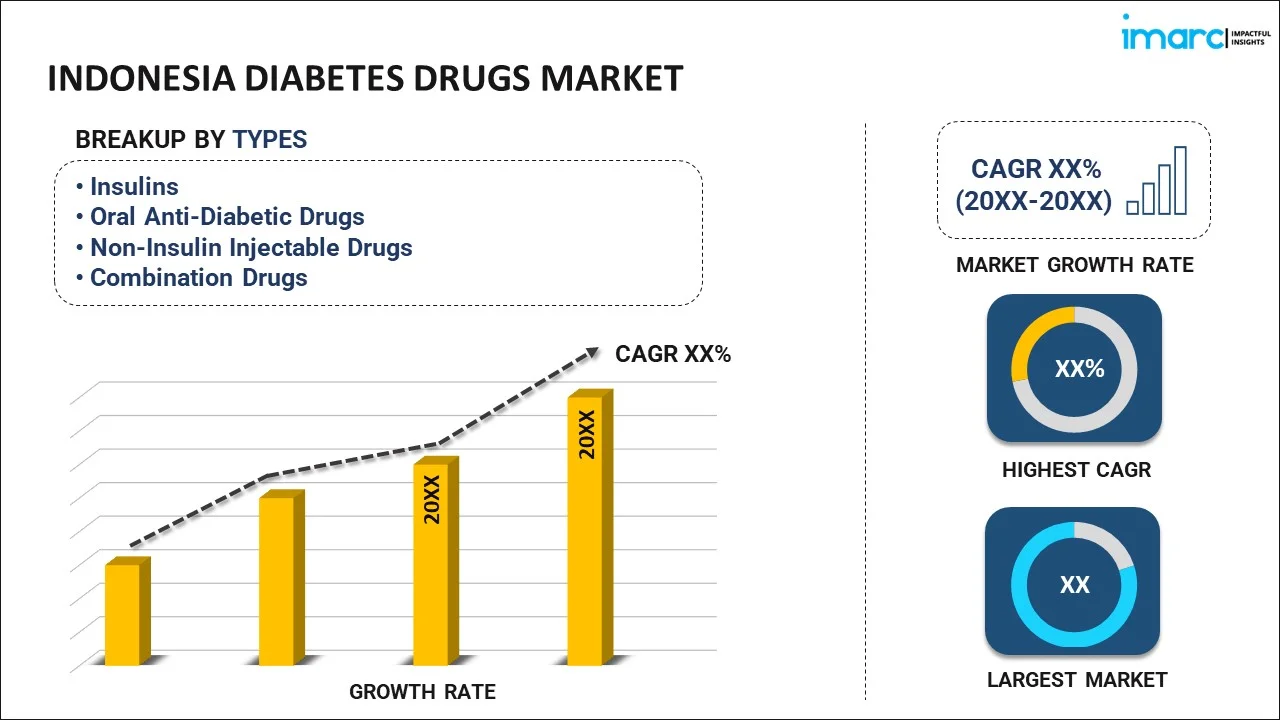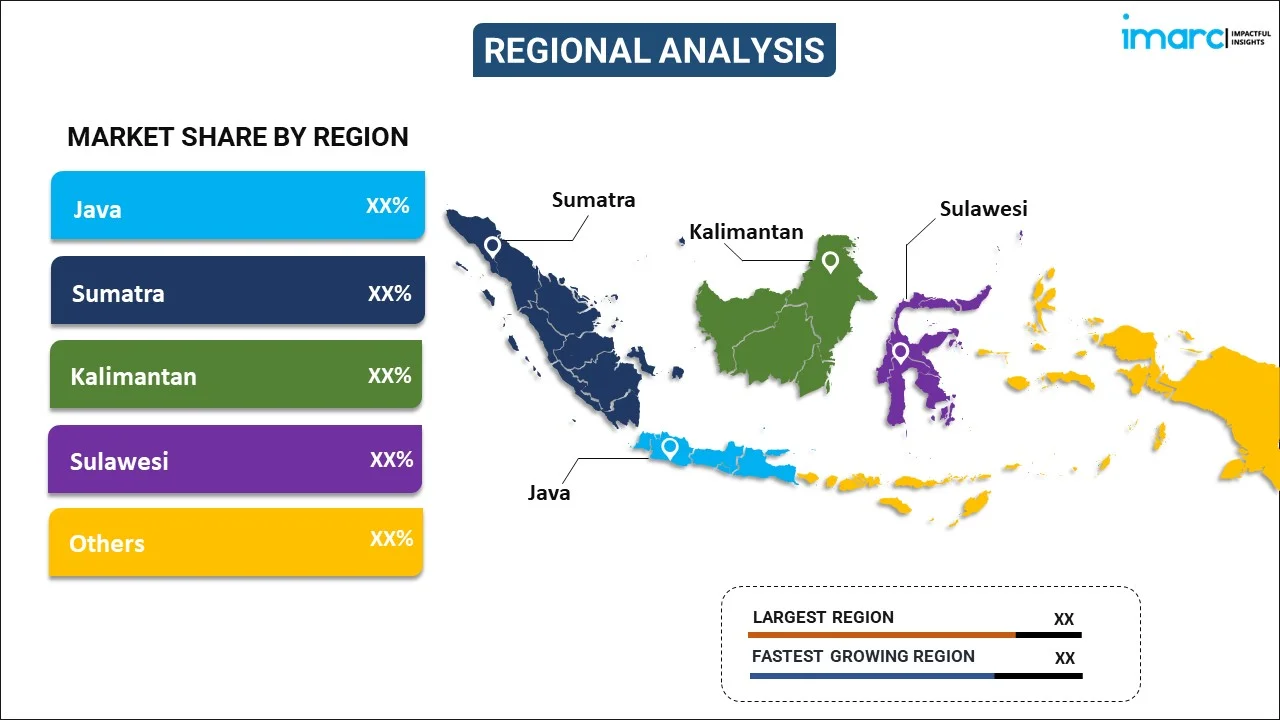
Indonesia Diabetes Drugs Market Report by Type (Insulins, Oral Anti-Diabetic Drugs, Non-Insulin Injectable Drugs, Combination Drugs), Distribution Channel (Online Pharmacies, Hospital Pharmacies, Retail Pharmacies), and Region 2025-2033
Market Overview:
Indonesia diabetes drugs market size reached USD 1.1 Billion in 2024. Looking forward, IMARC Group expects the market to reach USD 1.6 Billion by 2033, exhibiting a growth rate (CAGR) of 3.80% during 2025-2033. The increasing diabetes prevalence across the population, rising healthcare expenditure, increasing awareness and education through public campaigns, rapid urbanization and westernization, and expanding health insurance coverage regulatory compliance represent some of the key factors driving the market.
|
Report Attribute
|
Key Statistics
|
|---|---|
|
Base Year
|
2024
|
|
Forecast Years
|
2025-2033
|
|
Historical Years
|
2019-2024
|
|
Market Size in 2024
|
USD 1.1 Billion |
|
Market Forecast in 2033
|
USD 1.6 Billion |
| Market Growth Rate 2025-2033 | 3.80% |
Diabetes drugs, also known as antidiabetic medications, are pharmaceutical substances designed to manage and control diabetes mellitus. These medications play a crucial role in helping individuals with diabetes regulate their blood sugar levels and minimize the associated health risks. There are several classes of diabetes drugs, each with its unique mechanism of action. One common class is oral antidiabetic drugs, which are taken by mouth in the form of pills or tablets. These include metformin, sulfonylureas, and DPP-4 inhibitors. Metformin, for example, works by reducing the liver's glucose production and increasing insulin sensitivity in the cells of the body. Another class consists of injectable medications such as insulin and GLP-1 receptor agonists. Insulin is essential for individuals with type 1 diabetes and may also be necessary for those with type 2 diabetes who cannot manage their blood sugar adequately with oral medications alone. SGLT-2 inhibitors and thiazolidinediones are additional classes of diabetes drugs that work by targeting specific mechanisms in the body to help lower blood sugar levels.
Indonesia Diabetes Drugs Market Trends:
One of the primary drivers of the diabetes drugs market in Indonesia is the alarming increase in the prevalence of diabetes. Factors, such as sedentary lifestyles, changing dietary habits, and a growing aging population, have contributed to a higher incidence of both type 1 and type 2 diabetes. Additionally, as the economy of Indonesia grows, so does the disposable income of its population. This has led to increased healthcare spending, including on medications for chronic conditions like diabetes. Improved access to healthcare services and medications has escalated the demand for diabetes drugs. Other than this, public awareness campaigns and educational initiatives by both the government and non-governmental organizations have played a vital role in educating Indonesians about diabetes. As awareness grows, more individuals are seeking medical attention and appropriate medications for diabetes management. Besides this, expanding health insurance coverage, both through government schemes and private insurers, has made it easier for individuals to access diabetes medications and healthcare services. This has removed financial barriers to treatment. In line with this, Indonesia is undergoing an epidemiological transition, with a shift from infectious diseases to non-communicable diseases like diabetes. This transition places a greater emphasis on chronic disease management, including diabetes, and drives the market for related drugs. Furthermore, advancements in diabetes treatment options, including new drug formulations and delivery systems, have improved the effectiveness and convenience of diabetes management. These innovations have encouraged patients to adhere to treatment regimens.
Indonesia Diabetes Drugs Market Segmentation:
IMARC Group provides an analysis of the key trends in each segment of the market, along with forecasts at the country level for 2025-2033. Our report has categorized the market based on type and distribution channel.
Type Insights:

- Insulins
- Basal or Long Acting Insulins
- Bolus or Fast Acting Insulins
- Traditional Human Insulins
- Biosimilar Insulins
- Oral Anti-Diabetic Drugs
- Biguanides
- Alpha-Glucosidase Inhibitors
- Dopamine D2 Receptor Agonist
- SGLT-2 Inhibitors
- DPP-4 Inhibitors
- Sulfonylureas
- Meglitinides
- Non-Insulin Injectable Drugs
- GLP-1 Receptor Agonists
- Amylin Analogue
- Combination Drugs
- Insulin Combinations
- Oral Combinations
The report has provided a detailed breakup and analysis of the market based on the type. This includes insulins (basal or long acting insulins, bolus or fast acting insulins, traditional human insulins, and biosimilar insulins), oral anti-diabetic drugs (biguanides, alpha-glucosidase inhibitors, dopamine D2 receptor agonist, SGLT-2 inhibitors, DPP-4 inhibitors, sulfonylureas, and meglitinides), non-insulin injectable drugs (GLP-1 receptor agonists and amylin analogue), and combination drugs (insulin combinations and oral combinations).
Distribution Channel Insights:
- Online Pharmacies
- Hospital Pharmacies
- Retail Pharmacies
A detailed breakup and analysis of the market based on the distribution channel have also been provided in the report. This includes online pharmacies, hospital pharmacies, and retail pharmacies.
Regional Insights:

- Java
- Sumatra
- Kalimantan
- Sulawesi
- Others
The report has also provided a comprehensive analysis of all the major regional markets, which include Java, Sumatra, Kalimantan, Sulawesi, and Others.
Competitive Landscape:
The market research report has also provided a comprehensive analysis of the competitive landscape in the market. Competitive analysis such as market structure, key player positioning, top winning strategies, competitive dashboard, and company evaluation quadrant has been covered in the report. Also, detailed profiles of all major companies have been provided.
Indonesia Diabetes Drugs Market Report Coverage:
| Report Features | Details |
|---|---|
| Base Year of the Analysis | 2024 |
| Historical Period | 2019-2024 |
| Forecast Period | 2025-2033 |
| Units | Billion USD |
| Scope of the Report | Exploration of Historical and Forecast Trends, Industry Catalysts and Challenges, Segment-Wise Historical and Predictive Market Assessment:
|
| Types Covered |
|
| Distribution Channels Covered | Online Pharmacies, Hospital Pharmacies, Retail Pharmacies |
| Regions Covered | Java, Sumatra, Kalimantan, Sulawesi, Others |
| Customization Scope | 10% Free Customization |
| Post-Sale Analyst Support | 10-12 Weeks |
| Delivery Format | PDF and Excel through Email (We can also provide the editable version of the report in PPT/Word format on special request) |
Key Questions Answered in This Report:
- How has the Indonesia diabetes drugs market performed so far and how will it perform in the coming years?
- What has been the impact of COVID-19 on the Indonesia diabetes drugs market?
- What is the breakup of the Indonesia diabetes drugs market on the basis of type?
- What is the breakup of the Indonesia diabetes drugs market on the basis of distribution channel?
- What are the various stages in the value chain of the Indonesia diabetes drugs market?
- What are the key driving factors and challenges in the Indonesia diabetes drugs?
- What is the structure of the Indonesia diabetes drugs market and who are the key players?
- What is the degree of competition in the Indonesia diabetes drugs market?
Key Benefits for Stakeholders:
- IMARC’s industry report offers a comprehensive quantitative analysis of various market segments, historical and current market trends, market forecasts, and dynamics of the Indonesia diabetes drugs market from 2019-2033.
- The research report provides the latest information on the market drivers, challenges, and opportunities in the Indonesia diabetes drugs market.
- Porter's five forces analysis assist stakeholders in assessing the impact of new entrants, competitive rivalry, supplier power, buyer power, and the threat of substitution. It helps stakeholders to analyze the level of competition within the Indonesia diabetes drugs industry and its attractiveness.
- Competitive landscape allows stakeholders to understand their competitive environment and provides an insight into the current positions of key players in the market.
Need more help?
- Speak to our experienced analysts for insights on the current market scenarios.
- Include additional segments and countries to customize the report as per your requirement.
- Gain an unparalleled competitive advantage in your domain by understanding how to utilize the report and positively impacting your operations and revenue.
- For further assistance, please connect with our analysts.
 Inquire Before Buying
Inquire Before Buying
 Speak to an Analyst
Speak to an Analyst
 Request Brochure
Request Brochure
 Request Customization
Request Customization




.webp)




.webp)












